

Pacific Region Members,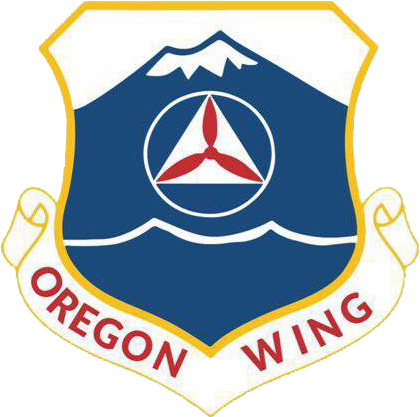 Recently, Oregon Wing Commander Col Bill Ray and his staff presented a proposal to me to change the ORWG emblem from the older round design to the shield design which is more in keeping with a wing emblem under the Air Force's most recent heraldry guidelines. He and his staff prepared a justification complete with the heraldry for the new emblem which was submitted to the National Uniform Committee and the National Commander for consideration. I am pleased to report that both have approved the new design. Below is the new approved design.
Recently, Oregon Wing Commander Col Bill Ray and his staff presented a proposal to me to change the ORWG emblem from the older round design to the shield design which is more in keeping with a wing emblem under the Air Force's most recent heraldry guidelines. He and his staff prepared a justification complete with the heraldry for the new emblem which was submitted to the National Uniform Committee and the National Commander for consideration. I am pleased to report that both have approved the new design. Below is the new approved design.
When considering any emblem, the heraldry is very important. Every aspect of the emblem has significance and should be able to be explained. Below is the heraldry for the new ORWG emblem.
"The peak is representative of Mt Hood, a recognizable and appropriate symbol for the Oregon Wing as it is the highest peak in the State of Oregon. The sweeping line below the propeller represents the wave of the Pacific Ocean which holds sway over the elements in much of the state and demonstrates that CAP's responsibilities extend all the way to the Oregon Coast. Its azure color is symbolic of the constancy of the Airmen in the Oregon Wing and the red propeller inscribed within a white triangle, inside a blue circle is the original Civil Air Patrol symbol, indicating a connection to our Civil Defense roots."
Effective immediately, the wing is authorized to use this design as their new emblem. Please join me in congratulating the Oregon Wing on their new wing emblem and on ushering in a new era of growth and prosperity for their wing.
Regards,
Col Jon Stokes, CAP
Pacific Region Commander
Information provided by:
Oregon Wing
May 31, 2017

Operation Blister was founded by Major David L Wagner of Group 1, and ran from June 1982 to June 1989. The program was comprised of a series of classes held once a week for one year. Cadet and Senior Member students were taught survival skills, and how to perform search and rescue missions in any terrain or condition within the United States - including a water survival class! At the end of the year, students were administered a written with a minimum 75% passing score. This was followed by a seven day field exercise, during which students would hike an average of 100 miles, and use only their personnal survival equipemnt for 24 to 72-hour periods. The program received a lot of support from the Army National Guard and Marine Corps, in the form of tents, generators, transportation and even instuctors.
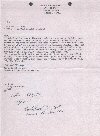
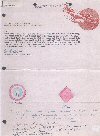 Major Wagner sent a letter [ left ] to Oregon Wing Commander, Colonel Earl G Smith, requesting a unique patch be created for wear by Operation Blister graduates. Aparently, a submitted patch design was approved on 08 May 1985, but never manufactured.
Major Wagner sent a letter [ left ] to Oregon Wing Commander, Colonel Earl G Smith, requesting a unique patch be created for wear by Operation Blister graduates. Aparently, a submitted patch design was approved on 08 May 1985, but never manufactured.
The following October, Major Wagner expressed concern to Colonel Smith [ right ] over the cost-per-member of creating a their own custom patch. He suggested using one of two readily available patches as less expensive alternatives, and the US Army 1st Logistical Command shoulder patch was selected.
In November, the Oregon Wing Commander approved wear of the patch by all graduates of Operation Blister, and was awarded retro-actively. While the Army wore the patch on their shoulder with the arrow pointing to the northwest, Operation Blister graduates wore it on their right breast pocket with the arrow pointing due north.
Information provided by:
Mrs Sandy Warwick
Tulsa, OK
March 2009

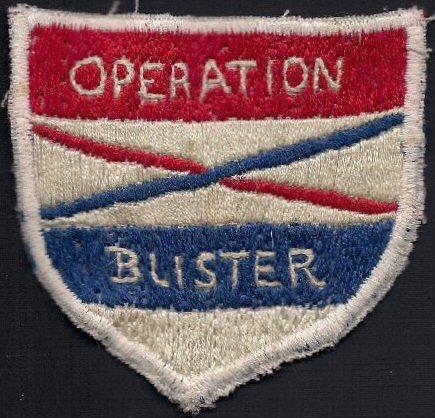 The second version patch was designed by Operation Blister founder, Major David L Wagner of Group 1, Oregon Wing. A single sample patch [at right] was hand made during the approval process.
The second version patch was designed by Operation Blister founder, Major David L Wagner of Group 1, Oregon Wing. A single sample patch [at right] was hand made during the approval process.
With slight modification to the sample patch, only 30 copies of the final design were produced. All 30 patches were missing the period after the letter "P" due to a manufacturer mistake. It's beleived that Major Wagner actually wore the sample patch shown here.
At some point, an unauthorized person had more patches made and began to sell them to cadets. These patches did have the missing third period, however they were considered fakes by Operation Blister personnel. Only patches from the error batch were ever officially awarded to graduating students.
Information provided by:
Mrs Sandy Warwick
Tulsa, OK
March 2009

In the Fall of 1999, I became the newly appointed cadet commander of the Aurora Composite Squadron. Feeling that the squadron needed to develop some sort of a new identity, I challenged the cadets in the squadron to a patch designing contest. Having not specified any particular mascot and/or shape for the new patch there was some dissent and ultimately not enough votes to go around to pacify our need for the new emblem. From that point on, I decided to hold a vote for a mascot and slogan which after minimal debate was settled unanimously as "The Fearless Falcons."
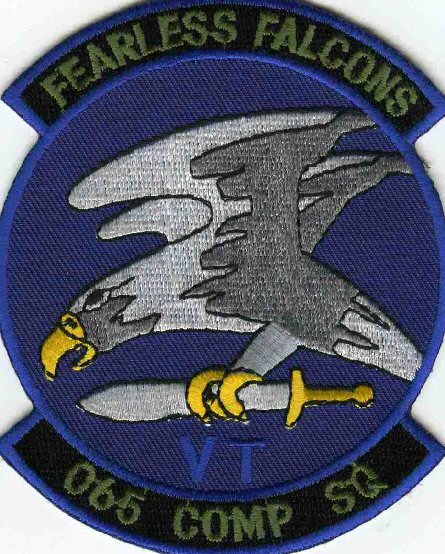 The new identity gave substance to our patch designing process. Since everyone new we were the "falcons" now, it was basically a solicitation of what orientation the falcon would be at on our patch. Additionaly, the cadets felt that there should also be some other items on the patch that would be of significance. These included Mt Hood in the foreground and the letters "VT" which was a memorial to Lt Col Emil Veer and Capt Chuck Thomas, two of our finest pilots in Oregon, who perished in a plane crash during the Pacfic Region Mountain Flying Clinic. After several months, we refined the image over and over. In fact, Some of the original artwork (or, "chicken scratch") is still around my house somewhere.
The new identity gave substance to our patch designing process. Since everyone new we were the "falcons" now, it was basically a solicitation of what orientation the falcon would be at on our patch. Additionaly, the cadets felt that there should also be some other items on the patch that would be of significance. These included Mt Hood in the foreground and the letters "VT" which was a memorial to Lt Col Emil Veer and Capt Chuck Thomas, two of our finest pilots in Oregon, who perished in a plane crash during the Pacfic Region Mountain Flying Clinic. After several months, we refined the image over and over. In fact, Some of the original artwork (or, "chicken scratch") is still around my house somewhere.
Ultimately, the creation of an actual embroidered patch would be delayed until the Fall of 2000. I joined the USAF in September of 2000 and left the artwork with the new Cadet Commander. He took it down to a local screen printing shop who re-drew the artwork and sent it off to have 50 of them made. This "original" version of the patch [shown here on the right] came back from the shop with some significant flaws. There was no Mt Hood and the colors were in the wrong places.
In 2003, I was now the Deputy Commander for Cadets for Aurora Composite Squadron, I took the original design to my close friend, Mr. Thad Jackson, who was a graphics design student at Portland State University. Over a cold beer one night, he told me that he needed an additional design to add to his graduate portfolio. He was in luck, because it just so happened to be that I was looking to redesign our squadron patch to a form that better reflected what the old group of cadets and I had originally wanted our squadron patch to look like.
Finally in 2006, after going through all of the appropriate channels for approval we began using the design on all of our letterheads and T-Shirts. Ultimately, we scrounged up enough money to get the patches made. In fact, it turned out that one of our "Cadet-moms" had an embroidery business and she custom made all of our patches for us.
This leaves us where we are at today. I am now the squadron commander and I have the priviledge of seeing our cadets sporting a patch that they are all very proud to wear on their BDUs.
Information provided by:
Captain Matthew J Brewer, Commander
Aurora Composite Squadron 65
June 2007

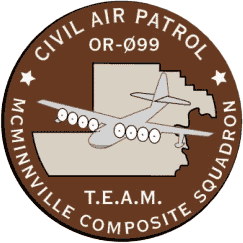 OR-099 is the Squadron Charter Identification number. OR represents that our Squadron is a proud member of the Oregon Wing of the Civil Air Patrol. 099 is our Squadron Identifcation number in the Oregon Wing.
OR-099 is the Squadron Charter Identification number. OR represents that our Squadron is a proud member of the Oregon Wing of the Civil Air Patrol. 099 is our Squadron Identifcation number in the Oregon Wing.
The GRAY AIRCRAFT is Howard Hughes' one-of-a-kind aviation aerospace treasure, the HK-1 (later the H-4) "Hurcules" Flying Boat. It represents Civil Air Patrol's mission in Aviation, Aviation History, Aerospace Education and how that relates to and benefits our Cadet Program. This historical Aircraft, more commonly known as the "Spruce Goose", is the centerpiece of the Captain Michael King Smith Educational Institute near our Squadron Headquarters.
The McMinnville Composite Squadron is proud to have a long standing relationship with the Evergreen Aviation & Space Museum. Our first major event as a new squadron was assisting Evergreen International Aviation with a private Air Show in the early 90s. It featured famous test pilot Bob Hoover. Since that time we have we have worked closely with Evergreen on many projects including the Museum.
The Outline of YAMHILL COUNTY represents the SERVICES the Squadron performs for OUR community, county and country.
The TWO STARS represent that the Squadron is a Composite Squadron and has CADETS and SENIOR MEMBERS, and our mission to both groups.
The letters T.E.A.M. represents Together Everyone Achieves More - it's the McMinnville Squadron's motto.
The BROWN COLORING represents that the Squadron is grounded in the CORE VALUES of the CIVIL AIR PATROL and the UNITED STATES AIR FORCE.
Our Squadron Patch was designed by Dave Herbert, of Evergreen International. The patch is on our BDUs and our squadron optional clothing. We are proud of it!
Information provided by:
McMinnville Composite Squadron,
with help from Gerrald Phillips